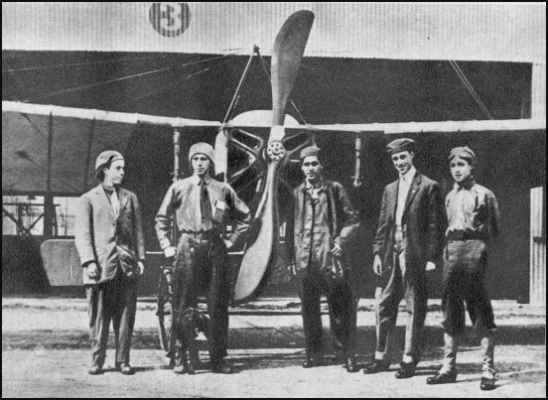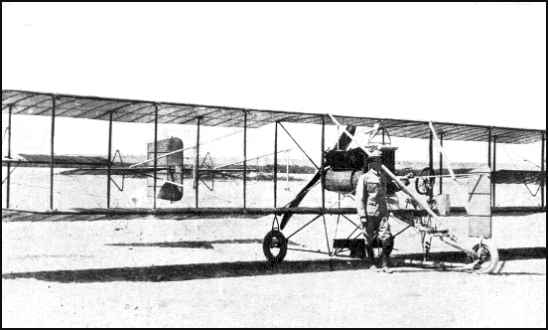Did You Know…?
In the early years of the twentieth century, the nature of warfare changed dramatically. The deployment of aircraft unleashed a powerful new weapon for warring factions, previously forced to rely only on their land and sea forces.
The earliest attempt to incorporate air power into fighting is thought to have been when an Italian pilot Giulo Gavoti threw grenades out of his Blériot XI in the general direction of a Turkish camp in Libya on Nov. 1, 1911. The following year, a Belgian pilot dropped bombs on a Turkish military base during the Balkan Wars. In August 1914, General Erich Ludendorff ordered the first air raid in history, when he called in zeppelins to bomb the city and forts of Liege in Belgium.
But the history of aerial warfare was not written only on that side of the Atlantic. The success of the Wright brothers and other pioneers in the U.S. attracted considerable attention in Mexico. In 1908, Alfredo Robles Domínguez published his Tratado de locomoción aérea (Treatise of Aerial Locomotion). In 1909, the Sociedad Impulsora de la Aviación, (Society for the Promotion of Aviation) was established in Mexico City. On January 8, 1910, Alberto Braniff successfully made Mexico’s first flight–all 500 meters of it–in a 60-horsepower Voisin biplane, taking off from the Balbuena field in Mexico City. Alberto Braniff was the son of industrialist and railroad entrepreneur Thomas Braniff. Alberto was sent to study in France, which is where he learned to fly and where he acquired a French built airplane which he subsequently brought back to Mexico when he returned. The family of Mexico’s pioneer aviator owned a home in Chapala, now occupied by the Cazadores restaurant. Despite the coincidence of name, Alberto Braniff was not related to the Braniff family in the U.S. that would later found the eponymous airline.
In 1911, Francisco I. Madero became Mexican President. He became a visionary supporter of aviation. On November 30, 1911, President Madero took a short historic flight in a Deperdussin airplane, thereby becoming the first Chief of State in the World to have flown in an aircraft. He was inspired by having witnessed, in March 1911, an international air show–the Moisant International Aviators–with its impressive display of flying.
John Moisant’s Flying Circus
John Moisant, taught to fly by Louis Blériot, designed, built and flew the first metal (aluminium) aircraft in 1909. Together with his brother Alfred, he founded the Moisant International Aviators, a flying circus which went on a barnstorming tour of the U.S. and Mexico (Monterrey, Mexico City and Veracruz).

In the words of Henry Serrano Villard, “the flying circus was a typically American phenomenon. Traveling by special train with built-in repair shop, the entourage included a tent and a dozen roustabouts, a dozen ticket sellers and press agents, a dozen aeroplanes and their mechanics, and eight death-defying aviators.” 1
John was killed in a flying accident in December 1910 and the circus was disbanded in 1911. Alfred Moisant returned to New York and opened an aviation school at Hempstead Plains, near Garden City, Long Island.
President Madero took office at a time when the nation was in turmoil, right at the beginning of what would later be known as the Mexican Revolution. Appreciating the potential intelligence gathering role of aircraft, Madero decided to acquire some planes. He sponsored five young Mexicans to travel to Long Island, New York, to train as pilots at the Moisant International Aviators School. The “Famous Five” were Gustavo Salinas Camiña, Alberto Salinas Carranza, Horacio Ruiz Gaviño and two brothers, Juan Pablo and Eduardo Aldasoro Suárez. Gustavo Salinas Camiña (18931964), who received his first commercial license (number 172) from the Aero Club of America at Flushing Meadows, New York, in 1912, was soon to write his own page in aviation history.
The five young pilots completed their mission and returned to Mexico. Following a coup d’état in 1913, General Victoriano Huerta claimed power and Madero was assassinated. Madero supporters rallied behind General Venustiano Carranza who assigned two of Mexico’s newly acquired airplanes to the command of General Álvaro Obregón in the Northwest.
In April 1914, one of Obregón’s gunships, the Tampico, was sailing off the coast of Sinaloa, close to the port of Topolobampo (near Los Mochis), when it came under attack from two Huertista warships: the Morelos and the Guerrero. Obregón ordered Gustavo Salinas Camiña to do something about it. On April 14, accompanied by his mechanic Teodoro Madariaga, Salinas flew Sonora, his Glenn Martin pusher biplane, overhead and began bombing the Guerrero. The Huertista warships put out to sea, and the Tampico survived to fight another day. Two months later, however, when the Tampico met up with the Guerrero again, it was less lucky. On that occasion, it caught fire and sank.
The action at the Battle of Topolobampo was the first naval-air skirmish in history. Aircraft had revolutionized the art of combat. War would never be the same again.

(from which he bombed the warship Morelos)
The significance of this major shift in warfare was clearly not lost on Salinas himself. Years later, in 1943, when he was chief of the Mexican Army Air Forces and on an inspection visit to Maxwell Field, Alabama, Major General Salinas recounted that, “The bombs I used were home-made, with a charge of 52 sticks of dynamite. Primitive as they were, they worked like a charm. At the time I was flying an old Wright pusher type. It occurred to me that the day would come when we would have planes of weight-carrying efficiency beyond one’s fondest hopes, and that then the plane would come into its own as a military assault weapon of fabulous power. That day has come.” 2
Gustavo Adolfo Salinas Camiña, the first airman to bomb a warship, died on March 5, 1964, at the age of 70, and was buried in the public cemetery of Cuatro Ciénegas de Carranza in the state of Coahuila. He is among those remembered each year on National Aviation Day (Día Nacional de la Aviación), celebrated every October 23rd.
This article is the basis for Chapter 17 in the author’s Mexican Kaleidoscope: myths, mysteries and mystique (Sombrero Books, 2016).
References
- 1 Villard, Henry Serrano (1968) Contact! The Story of the Early Birds. New York: Thomas Y Crowell Company, as quoted on Ralph Cooper’s website The Early Birds of Aviation on the page devoted to Moisant’s Cross-Channel Flight, 1910.
- 2 Quoted on Ralph Cooper’s website The Early Birds of Aviation on the page devoted to Gustavo Adolfo Salinas Camiña
Photos: Copyright uncertain, but photos believed to be in the collections of Gerardo Garcia de León and Luis Garcia de León respectively. Reproduced here by kind courtesy of Ralph Cooper – from https://www.earlyaviators.com/esaligus.htm and https://www.earlyaviators.com/esaligu3.htm


